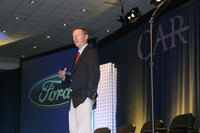C.A.R. Management Briefing Seminars - Wednesday
 |
CAR MANAGEMENT BRIEFING SEMINARS 2007
Wednesday’s Insights in
Traverse City
By Steve Purdy
TheAutoChannel.com
Detroit Bureau
Traverse City, MI – August 9, 2007 – Featured speaker at the Wednesday morning session, Ford’s new big boss Alan Mulally, charmed the audience with an extemporaneous talk about his first months at the helm of the struggling automaker. Unlike most of the speakers Mulally had no Power-Point or even notes as he expressed confidence in Ford’s future. Of course that’s his job, and he did it well. When asked what prompted him to take on such a daunting task as bringing Ford back from the brink he talked about the irresistible challenge of heading up the come-back of an iconic American brand in a classically American industry. While his speech was short on details, disappointing some in the audience, it was long on confidence.
What must Ford do, first to survive, then to thrive? Deal with over capacity. Get legacy costs under control. Accelerate development of new products that consumers want to buy. And develop more flexible factories to respond more quickly to market shifts. No surprises there. In fact, that list sounds like a cliché. The challenges that face all the domestic auto makers, of course, make Ford’s way forward a challenge as well.
During the panel discussions with his colleagues Mulally was asked about the biggest surprise he faced upon taking over at Ford. He didn’t hesitate before talking about CAFÉ (the Federal government’s Corporate Average Fuel Economy standards). He said he couldn’t understand why the government thinks that distorting the market so drastically is such a good thing. That topic immediately inspired the entire panel and the audience perked up perceptibly.
Another of Mulally’s messages was that a higher fuel tax would be a better way to drive the auto market in the desired direction. While he didn’t go so far as to call for the oft-referenced 50-cent/gallon increase, Mulally insists that “it is necessary that the auto industry join in the debate.”
The other panelists who spoke earlier were: Jim Lentz, executive VP of Toyota Motor Sales USA, Chip McClure, chairman, CEO and president of tier one supplier Arvin Meritor, John Krafcik, VP Product Development and Strategic Planning for Hyundai Motor America. Discussions ranged from alternative fuels to business philosophy, to advanced powertrains – too much to list here. Just let it be known that this reporter was impressed with the confidence and insights shared by all the speakers.
John Krafcik of Hyundai got my attention when he showed the drawing of the swoopy new five-door sport hatchback due out next year. Based on the Elantra platform this one is called Elantra Touring and will have nothing special under the hood but it sure looks great. It only took the Koreans about 10 years to become major players in the US market after it took the Japanese about 20. Some analysts here speculate that the Chinese will take only about 5 years. By interpolation I’ll suggest that next it will be the Indians who may take just a few years.
Most entertaining event of the morning was Mr. Lentz’ offering of the 1960s era Toyota Corona commercial featuring a comic race with a jet-powered dragster. The Toyota won by a whisker, believe it or not, but it wasn’t a fair race, as you might guess. Lentz also talked about Scion’s marketing philosophy to skeptical, independent youngsters who insist on individuality, honesty and respect. Advertising and marketing is entirely different today than when that Corona commercial was made, but I’d sure like to see that kind of humor back to advertising.
Regarding alternative fuels we learned that cellulosic biofuels are the coming thing. Corn is inefficient and encroaches on food production - corn flakes, margarine and steak. Other grain-based and even sugar cane-based ethanol production has similar problems. But cellulose is more efficiently produced and the raw product starts out as waste anyway, like sawdust and forest debris. The pernicious pine beetle is devastating forests leaving flammable litter on the forest floor that needs to be used for something. And, you may recall we recently wrote about a new coal to liquid (diesel fuel) plant being proposed for southeast Wyoming. This TC event is a good place to explore some of those technologies as well.
In terms of alternative powertrains look for plug-in hybrids (requires the further development of battery technology), more diesels than the US has seen before, hydrogen fuel cells (still quite a few years away), and plenty more hybrids of all persuasions.
Dealing with a huge over-capacity problem along with out-of-control labor costs are big issues with all auto makers but particularly the domestics. Worldwide capacity for motor vehicle manufacturing (that’s everyone) is about 85 million, but worldwide sales are about 65 million. Is something wrong with this picture?
Talking about the current labor/management issues Sean McAlinden, CAR’s chief economist, speculates that GM so wants to mitigate its health care cost problems that they may give away other benefits during negations that are going on now. McAlinden, the prematurely white-haired academic, always seems to have a joke bubbling just below the surface so he’s fun to listen to. He insists there is virtually no chance of a strike with this contract.
Much of the fun at the Management Briefing Seminars happens around the social activities - hospitality every afternoon after the sessions and a big outdoor banquet on Wednesday evening on the fairway of the golf course. Classic networking is intense and our Wednesday evening entertainment was Second City comedy followed by dancing to a high-energy Motown band.
© Steve Purdy, Shunpiker Productions, All Rights Reserved



